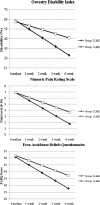Effect of slump stretching versus lumbar mobilization with exercise in subjects with non-radicular low back pain: a randomized clinical trial
- PMID: 23372392
- PMCID: PMC3267445
- DOI: 10.1179/2042618611Y.0000000015
Effect of slump stretching versus lumbar mobilization with exercise in subjects with non-radicular low back pain: a randomized clinical trial
Abstract
Previous case reports, case series, and pilot studies have suggested that slump stretching may enhance the effects of spinal mobilization and stabilization exercises in patients with non-radicular low back pain (NRLBP). The purpose of this trial was to determine if slump stretching results in improvements in pain, disability, and fear and avoidance beliefs in patients with NRLBP with neural mechanosensitivity. Sixty patients, 18-60 years of age presenting with NRLBP with symptom duration >3 months, were randomized into one of two, 3-week physical therapy programs. Group one received lumbar spinal mobilization with stabilization exercises while group two received slump stretching in addition to lumbar spinal mobilization with exercise. Outcomes including the modified Oswestry disability index (ODI), numeric pain rating scale (NPRS), and the fear-avoidance belief questionnaire (FABQ) were collected at baseline, and at weeks 1, 2, 3, and 6. A doubly multivariate analysis of variance revealed a significant group-time interaction for ODI, NPRS, and FABQ. There were large within-group changes for all outcomes with P<0·01 and large between-group differences at weeks 3 and 6 for the ODI and weeks 1, 2, 3, and 6 for the NPRS and FABQ at P<0·01. A linear mixed-effect model comparing the composite slopes of the improvement lines revealed significant differences favoring the slump stretching group at P<0·01. The findings of the present study further support the use of slump stretching with spinal mobilization and stabilization exercises when treating NRLBP.
Keywords: Low back pain; Neurodynamics; Slump stretching; Slump test.
Figures





Similar articles
-
Slump stretching in the management of non-radicular low back pain: a pilot clinical trial.Man Ther. 2006 Nov;11(4):279-86. doi: 10.1016/j.math.2005.07.002. Epub 2005 Dec 27. Man Ther. 2006. PMID: 16380286 Clinical Trial.
-
Effectiveness of Simulated Horseback Riding for Patients With Chronic Low Back Pain: A Randomized Controlled Trial.J Sport Rehabil. 2020 Feb 1;29(2):179-185. doi: 10.1123/jsr.2018-0252. J Sport Rehabil. 2020. PMID: 30676224 Clinical Trial.
-
Effectiveness of Slump Stretching on Low Back Pain: A Systematic Review and Meta-analysis.Pain Med. 2019 Feb 1;20(2):378-396. doi: 10.1093/pm/pny208. Pain Med. 2019. PMID: 30590849
-
The short-term effects of instrument-based mobilization compared with manual mobilization for low back pain: A randomized clinical trial.J Back Musculoskelet Rehabil. 2023;36(2):407-418. doi: 10.3233/BMR-220042. J Back Musculoskelet Rehabil. 2023. PMID: 36120765 Clinical Trial.
-
The Effectiveness of Hollowing and Bracing Strategies With Lumbar Stabilization Exercise in Older Adult Women With Nonspecific Low Back Pain: A Quasi-Experimental Study on a Community-based Rehabilitation.J Manipulative Physiol Ther. 2018 Jan;41(1):1-9. doi: 10.1016/j.jmpt.2017.06.012. Epub 2017 Dec 16. J Manipulative Physiol Ther. 2018. PMID: 29254626 Review.
Cited by
-
Functional Changes in Patients and Morphological Changes in the Lumbar Intervertebral Disc after Applying Lordotic Curve-Controlled Traction: A Double-Blind Randomized Controlled Study.Medicina (Kaunas). 2019 Dec 19;56(1):4. doi: 10.3390/medicina56010004. Medicina (Kaunas). 2019. PMID: 31861714 Free PMC article. Clinical Trial.
-
The effects of hamstring stretching exercises on pain intensity and function in low back pain patients: A systematic review with meta-analysis of randomized controlled trials.SAGE Open Med. 2024 Jul 29;12:20503121241252251. doi: 10.1177/20503121241252251. eCollection 2024. SAGE Open Med. 2024. PMID: 39086556 Free PMC article. Review.
-
Sciatic nerve stiffness is not changed immediately after a slump neurodynamics technique.Muscles Ligaments Tendons J. 2018 Jan 10;7(3):583-589. doi: 10.11138/mltj/2017.7.3.583. eCollection 2017 Jul-Sep. Muscles Ligaments Tendons J. 2018. PMID: 29387655 Free PMC article.
-
Manipulation and mobilization for treating chronic low back pain: a systematic review and meta-analysis.Spine J. 2018 May;18(5):866-879. doi: 10.1016/j.spinee.2018.01.013. Epub 2018 Jan 31. Spine J. 2018. PMID: 29371112 Free PMC article.
-
Effectiveness of Neural Mobilisation on Pain Intensity, Functional Status, and Physical Performance in Adults with Musculoskeletal Pain - A Systematic Review with Meta-Analysis.Clin Rehabil. 2024 Feb;38(2):145-183. doi: 10.1177/02692155231215216. Epub 2023 Nov 21. Clin Rehabil. 2024. PMID: 37990512 Free PMC article.
References
-
- Frymoyer JW. Back pain and sciatica. N Engl J Med 1988;318:291–300 - PubMed
-
- Stankovic R, Johnell O, Maly P, Willner S. Use of lumbar extension, slump test, physical and neurological examination in the evaluation of patients with suspected herniated nucleus pulposus. A prospective clinical study. Man Ther 1999;4:25–32 - PubMed
-
- Cyriax J. Textbook of orthopaedic medicine, Volume one: diagnosis of soft tissue lesions. 6th ed. London: Baillière Tindall; 1975. p. 390–7
LinkOut - more resources
Full Text Sources
